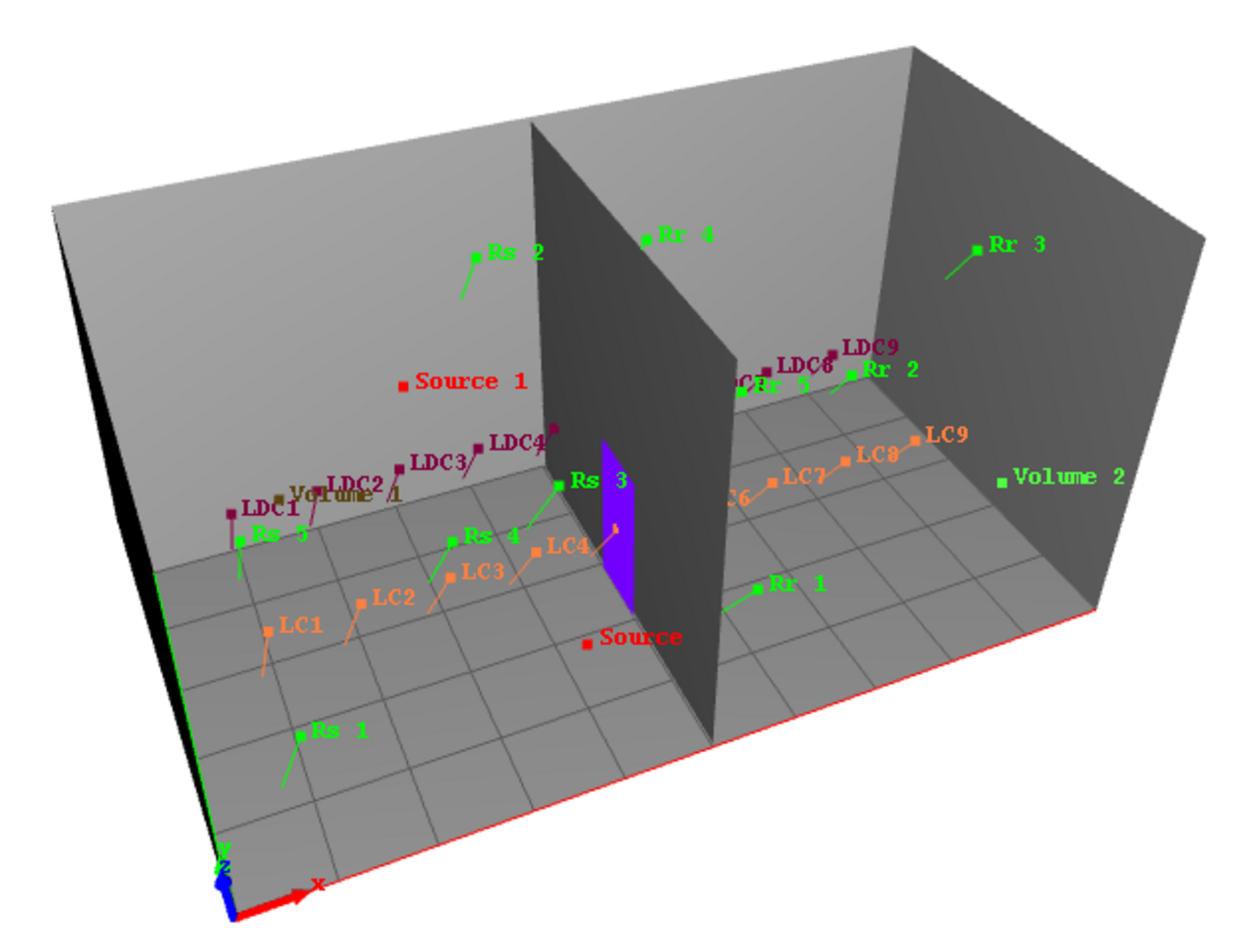All elements of this simulation are licensed under Licence Creative Commons Attribution 4.0 International License.
Two coupled cubic rooms with or without a door in a separation wall
Description
Academic case: Comparison between SPPS and the classical theory of coupled rooms, for 2 cubic rooms (5m x 5m x 5m) [10% absorption, 100% diffusely reflecting] with or without a 1.8m² door (open, closed (no transmission) or R=10 dB) in a separation wall with an insertion loss R=10, 20, 30 dB
What is tested?
Comparison between SPPS and theoretical results from the classical theory of reverberation applied to coupled rooms.
What is tested?
Comparison between SPPS and theoretical results from the classical theory of reverberation applied coupled rooms.
Description
Academic case: Comparison between SPPS and the classical theory of coupled rooms, for 2 cubic rooms (5m x 5m x 5m) [10% absorption, 100% diffusely reflecting] with or without a door (door open, closed (no transmission or R=10 dB) in a separation wall with an insertion loss R=10, 20, 30 dB
Reference


All elements of this simulation are licensed under a Creative Commons Attribution 4.0 International License.
Reference
CAUTION - The following results present comparisons between numerical simulations carried out with I-Simpa and 'reference' data available in the scientific literature.
- It is difficult to prejudge the concept of 'reference'. The deviation between the simulations and the reference data that can be observed do not necessarily call into question the corresponding simulations but can also be associated with other sources of deviation (modeling assumptions, numerical instabilities, experimental uncertainties, etc.).
- Note also that these comparaisons can also show the limitations of some numerical codes.
Results
Insertion loss between the receiver room and the source room
| Case | R door (dB) | R separation wall (dB) | Theory | SPPS (2010) | SPPS (2018) | MD_Comsol (2010) | MD_Octave (2018) | |
|---|---|---|---|---|---|---|---|---|
| 1 | No wall (open) | No wall (open) | 1.76 | 0.83 | 0.80 | 0.94 | 0.95 | |
| 2 | 0 (transparent, i.e. open) | 0 (transparent, i.e. open) | 1.76 | 0.82 | 0,82 | 0.89 | 2.57 | |
| 3 | 10 | 10 | 7.78 | 7.26 | 7.25 | 7.78 | 7.79 | |
| 4 | 20 | 20 | 17.78 | 17.31 | 17.22 | 17.81 | 17.81 | |
| 5 | 30 | 30 | 27.78 | 27.10 | 27.22 | 27.85 | 27.81 | |
| 6 | Closed & No transmission | 10 | 8.11 | 7.59 | 7.58 | 8.11 | 8.13 | |
| 7 | 10 | No transmission | 19.21 | 18.53 | 18.69 | 19.07 | 19.02 | |
| 8 | 0 (transparent, i.e. open) | No transmission | 9.65 | 9.25 | 9.25 | 2.85 | 5.96 |
In this situation, we compared the insertion loss (IL in dB) between the source and receiver rooms. This insertion loss is calculated by averaging the sound level at 5 receivers inside each room for several configurations of the separation wall (with or without a door). This insertion loss can be compared to the theoretical value, obtained by applying the theoretical theory of reverberation of coupled rooms.
The results are given in the following table.
- Note that the case R=0 dB means that the surface is perfectly transparent (no wall separation).
- The IL obtained using the theory and the numerical simulations, always differ from the values R imposed on the door and on the separation wall, due the theory hypothesis and due to the estimation of the average sound level in a room.
In theory, regarding the two first lines of the table (cases 1 and 2), if the numerical codes are perfectly coherent with the expected physical behavior, the case without a separation wall (#1) should be equivalent to the case (#2) of two rooms coupled through a transparent wall. In practice, this is verified for the SPPS code, but not for the MD code. Considering the diffusion model, the implementation considers two distinct volumes for calculating the diffusion coefficient (that is the main parameter of the MD code); the diffusion coefficient is necessary different to the one calculated with a single (and larger) room,which should justify the fact that values should be different for cases 1 and 2 for the DM_Comsol as well for the DM_Octave. By observing the case 8, where a surface present a value of 0 dB for R, one can see that the DM_Comsol give similar results than SPPS, which should confirm that the DM_Comsol gives the expected result. In this case, the DM_Octave seems not relevant.
Concerning the configurations with a transmission loss that is not equal to 0 (cases 2 to 7), we observe a very good agreement between the SPPS/MD codes and the theory of coupled rooms.
Calculation parameters
Reference
| Parameters | Value |
|---|---|
| Active calculation of Atmospheric absorption | NO |
| Active calculation of diffusion by fitting objects | NO |
| Active calculation of direct field only | NO |
| Active calculation of transmission | YES |
| Calculation method | Random |
| Limit value of the particle extinction | 5.0 |
| Number of sound particles per source | 1 000 000 |
| Number of sound particles per source (display) | |
| Random initialization number | |
| Receiver radius | 0.31 |
| Simulation length (s) | 1.5 |
| Time step (s) | 0.01 |
Reference (copie 1)
| Parameters (MD_Octave) | Value |
|---|---|
| Active calculation of Atmospheric absorption | NO |
| Merge with direct field | YES |
| Diffusion equation resolution - Maximum number of iterations | 200 |
| Diffusion equation resolution - Tolerance | 0.000001 |
| Simulation length (s) | 2.000 |
| Time step (s) | 0.001 |


